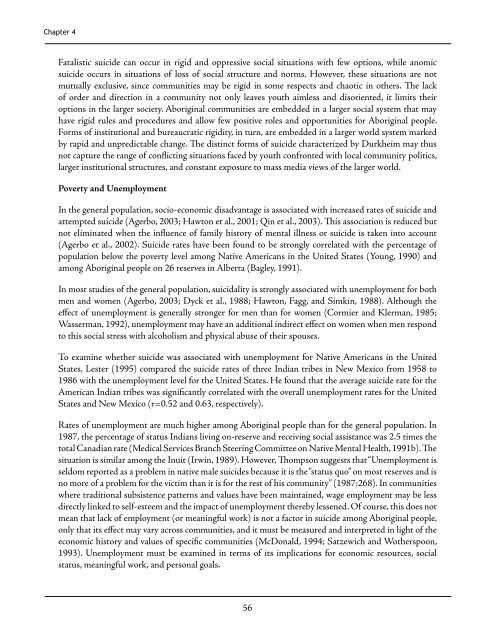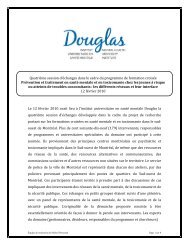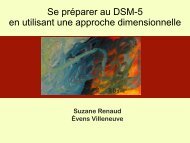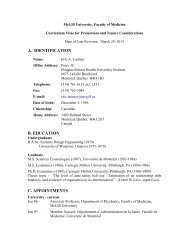Suicide Among Aboriginal People in Canada - Institut universitaire ...
Suicide Among Aboriginal People in Canada - Institut universitaire ...
Suicide Among Aboriginal People in Canada - Institut universitaire ...
Create successful ePaper yourself
Turn your PDF publications into a flip-book with our unique Google optimized e-Paper software.
Chapter 4Fatalistic suicide can occur <strong>in</strong> rigid and oppressive social situations with few options, while anomicsuicide occurs <strong>in</strong> situations of loss of social structure and norms. However, these situations are notmutually exclusive, s<strong>in</strong>ce communities may be rigid <strong>in</strong> some respects and chaotic <strong>in</strong> others. The lackof order and direction <strong>in</strong> a community not only leaves youth aimless and disoriented, it limits theiroptions <strong>in</strong> the larger society. <strong>Aborig<strong>in</strong>al</strong> communities are embedded <strong>in</strong> a larger social system that mayhave rigid rules and procedures and allow few positive roles and opportunities for <strong>Aborig<strong>in</strong>al</strong> people.Forms of <strong>in</strong>stitutional and bureaucratic rigidity, <strong>in</strong> turn, are embedded <strong>in</strong> a larger world system markedby rapid and unpredictable change. The dist<strong>in</strong>ct forms of suicide characterized by Durkheim may thusnot capture the range of conflict<strong>in</strong>g situations faced by youth confronted with local community politics,larger <strong>in</strong>stitutional structures, and constant exposure to mass media views of the larger world.Poverty and UnemploymentIn the general population, socio-economic disadvantage is associated with <strong>in</strong>creased rates of suicide andattempted suicide (Agerbo, 2003; Hawton et al., 2001; Q<strong>in</strong> et al., 2003). This association is reduced butnot elim<strong>in</strong>ated when the <strong>in</strong>fluence of family history of mental illness or suicide is taken <strong>in</strong>to account(Agerbo et al., 2002). <strong>Suicide</strong> rates have been found to be strongly correlated with the percentage ofpopulation below the poverty level among Native Americans <strong>in</strong> the United States (Young, 1990) andamong <strong>Aborig<strong>in</strong>al</strong> people on 26 reserves <strong>in</strong> Alberta (Bagley, 1991).In most studies of the general population, suicidality is strongly associated with unemployment for bothmen and women (Agerbo, 2003; Dyck et al., 1988; Hawton, Fagg, and Simk<strong>in</strong>, 1988). Although theeffect of unemployment is generally stronger for men than for women (Cormier and Klerman, 1985;Wasserman, 1992), unemployment may have an additional <strong>in</strong>direct effect on women when men respondto this social stress with alcoholism and physical abuse of their spouses.To exam<strong>in</strong>e whether suicide was associated with unemployment for Native Americans <strong>in</strong> the UnitedStates, Lester (1995) compared the suicide rates of three Indian tribes <strong>in</strong> New Mexico from 1958 to1986 with the unemployment level for the United States. He found that the average suicide rate for theAmerican Indian tribes was significantly correlated with the overall unemployment rates for the UnitedStates and New Mexico (r=0.52 and 0.63, respectively).Rates of unemployment are much higher among <strong>Aborig<strong>in</strong>al</strong> people than for the general population. In1987, the percentage of status Indians liv<strong>in</strong>g on-reserve and receiv<strong>in</strong>g social assistance was 2.5 times thetotal Canadian rate (Medical Services Branch Steer<strong>in</strong>g Committee on Native Mental Health, 1991b). Thesituation is similar among the Inuit (Irw<strong>in</strong>, 1989). However, Thompson suggests that “Unemployment isseldom reported as a problem <strong>in</strong> native male suicides because it is the “status quo” on most reserves and isno more of a problem for the victim than it is for the rest of his community” (1987:268). In communitieswhere traditional subsistence patterns and values have been ma<strong>in</strong>ta<strong>in</strong>ed, wage employment may be lessdirectly l<strong>in</strong>ked to self-esteem and the impact of unemployment thereby lessened. Of course, this does notmean that lack of employment (or mean<strong>in</strong>gful work) is not a factor <strong>in</strong> suicide among <strong>Aborig<strong>in</strong>al</strong> people,only that its effect may vary across communities, and it must be measured and <strong>in</strong>terpreted <strong>in</strong> light of theeconomic history and values of specific communities (McDonald, 1994; Satzewich and Wotherspoon,1993). Unemployment must be exam<strong>in</strong>ed <strong>in</strong> terms of its implications for economic resources, socialstatus, mean<strong>in</strong>gful work, and personal goals.56
















